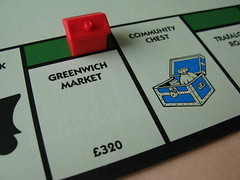In the battle over the future of Greenwich Market, it looks like the developers have blinked first. On Monday, “in response to public consultation,” Greenwich Hospital announced that one of the many controversial casualties of its “Bluewater” market masterplan – the cobbled floor – would be saved. Well, sort of.
As the they put it, “Changes to the regeneration plans have been submitted to Council planners….Greenwich Hospital will carefully raise, refurbish and re-lay all the cobbles in a new configuration interspersed with new granite setts. This will create a market floor of familiar appearance which will ensure this much-loved feature of the market is retained.”
What does that mean, exactly? Surely it cannot be both “new” and “familiar” at the same time? I’d love to be able to tell you what that “new configuration” will look like – but if the Hospital has indeed submitted “changes” to its planning application, the council hasn’t put them on its website yet.
My suspicion is that any changes are rather minor – the Hospital are, after all, the people who presented their wholesale demolition scheme as something which “maintains all the principles of Greenwich Market.” And even if the cobbled floor is substantially retained, the new development’s worst feature – its bland shopping-precinct feel – is still just as bad. This could well be a ploy to make us feel that we have achieved something, when little if anything has really improved.
But even if that is the case, this week’s is still an interesting and useful development. First, it gives the lie to the Hospital’s previous claim that it consulted properly and that people were happy with its plans. As you may remember, its much-bugled “public consultation” took place on two days in October 2007, not far off two years ago. This week’s change certainly didn’t come about “in response to” that – it came about in response to public pressure after coverage on this website, on the Greenwich Phantom and in the Evening Standard.
Secondly, the revision could – perhaps – slow things down further. Are you actually allowed to change a planning application half-way through? The application the public were invited to comment on by the council is now at least ostensibly different from the application that the council is considering. Shouldn’t we get a chance to express our views on the revised application before it goes to the planning committee? Shouldn’t the council’s public consultation process be restarted?
Thirdly, and most importantly, this move is a sign of weakness. It is an acknowledgement that the existing market does, in fact, have a heritage value and that heritage features are important in the context of this site. Which is what the council’s planning policies say; and which is also what, of course, we have been saying all along. By acknowledging this, the developers further weaken their case for their uncompromisingly modern scheme.
Am I reading too much into this? I don’t know. Maybe this change has been cooked up by the developers and the council as a token concession before they wave the bulldozers in. The red line for me is the nasty plastic shopping-precinct roof and the inappropriate shopping-precinct columns. While those remain in the scheme, it will remain unacceptable. Watch this space over the next few days for news of the next stage in the fight.
